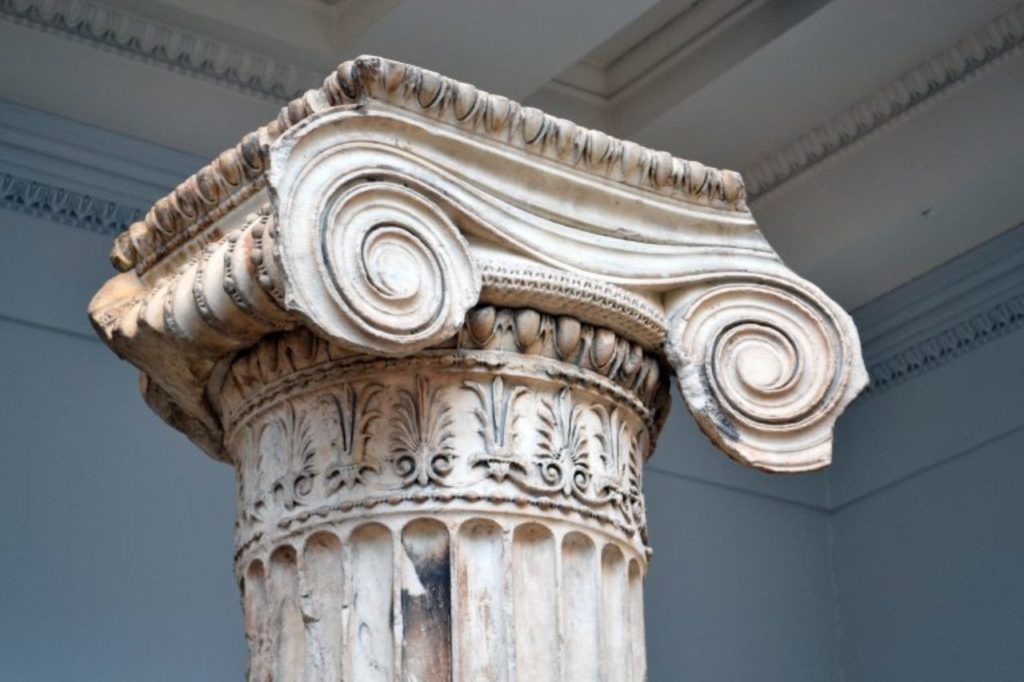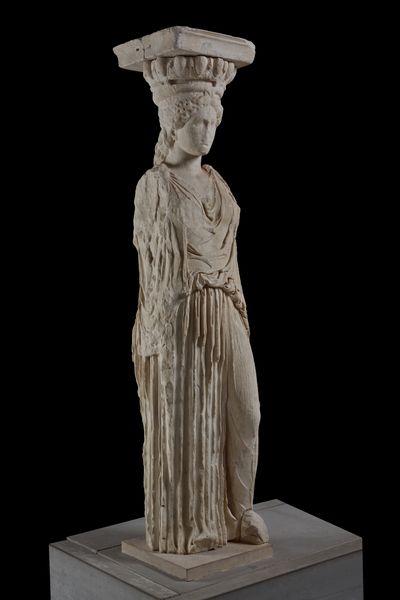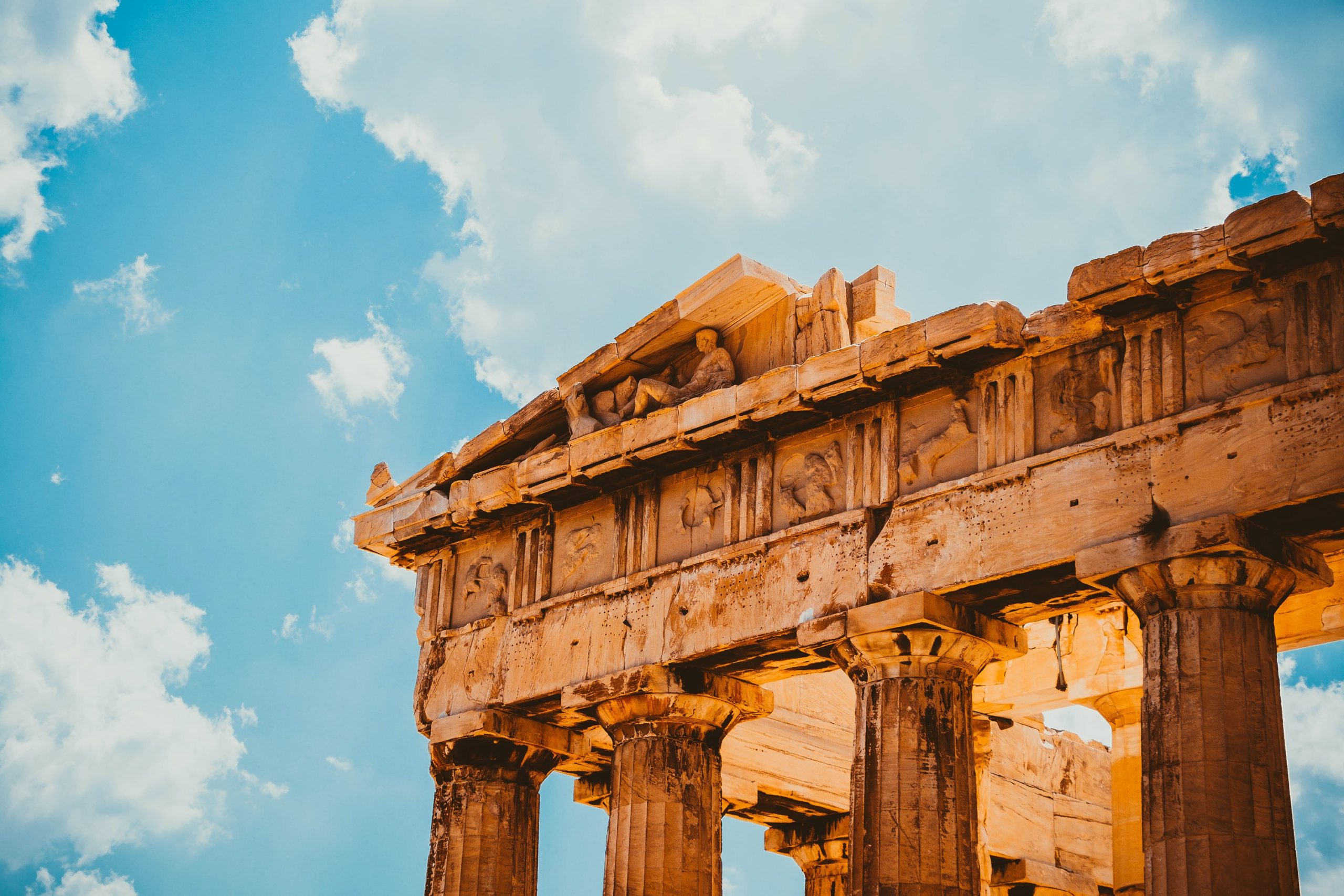This article will survey some of the Greek architecture of the ancient and classical past. It will also explain the reasons why the highlighted structures are distinctly Greek.
Before jumping into this list, it’s important to understand a few basic things about the Greek architecture of the ancient world. For starters, understand what motivated the ancient Greeks: They were inspired to achieve precision, beauty, and superior quality in art and architecture. We see this in the development of Greek sculpture throughout the three periods of ancient Greece.
Representations of the human form became increasingly realistic as artists learned to refine their craft. Comparisons between, say, the kouros boy (image below) from the Archaic period and sculptures of youths from the Classical and Hellenistic periods showcase this clearly.

In architecture, this also meant an increase in intricacy and opulence as Greek civilization progressed.
This is evident in the Classical Orders of Architecture. In ancient Greece, these are the Doric, the Ionic, and the Corinthian orders. Each is a hallmark of a different period of ancient Greece. The Greek architecture of the Archaic period, therefore, is not the same as that of the Hellenistic period. And, as almost 200 years separate the end of the former from the beginning of the latter, this should come as no surprise.
So, without further ado, let’s begin The Greek Architecture Guide with the most recognizable of ancient Greek temples: The Parthenon.
The Parthenon

The Parthenon sits on top of the Acropolis of Athens, hovering above the modern-day city just as it did thousands of years ago. It is, perhaps, the most famous Greek structure ever constructed.
The Parthenon was completed in 432 BC, during the Classical period of ancient Greece. However, it adheres mostly to the Doric Order, which has its origins in the Archaic period. And, for this reason, it has a rather severe appearance. The Parthenon lacks the decorative elements that we see in much of the Greek architecture that comes after it.

The building served as a temple and treasury during ancient Greek times. It was dedicated to Athena, the patron goddess of Athens. And inside of it, there was an enormous statue of her likeness that was made with ivory and gold.
The Erechtheion

Just across from the Parthenon is the Erechtheion. This structure had a similar function to that of the Parthenon. It was also a temple dedicated to Athena. But, in terms of architectural design, the two buildings have almost nothing in common.
The Erectheion, sometimes called the Erechtheum, subscribes to the Ionic Order. And, as such, we see more decorative elements, as well as slender Ionic columns that have volutes for capitals.

Perhaps the most distinctive aspect of the Erechtheion, however, are the six caryatids that support it. The caryatids are columns carved in marble to resemble women in ancient Greek garb. They support the porch of the Erechtheion.
We don’t know who these women are supposed to represent, or if they are supposed to represent anyone at all. Although, the Roman architect Vitruvius states that they represent Athenian women who sided with the Persians during the Greco-Persian Wars. As a punishment, they were condemned to stand in Greek garb forevermore.


Beyond this neat story, the caryatids are interesting and important because they represent a blending of sculpture and architecture. Each is a beautiful sculpture in its own right, but they’re all essential to the overall integrity of the structure.
The Temple of Apollo at Delphi

There were many oracle centers in the ancient Mediterranean world. But the most famous one was located in Delphi. This was the Pythian Oracle at the Temple of Apollo. According to myth, the god Apollo slayed a beast called Python on this site. The beast had been terrorizing the people of Parnassus, the region in which Delphi is located. And in honor of Apollo’s bravery, they built this cult center for his worship.
The reality is that this site is very old. Settlements here date back to the 2nd millennium BC. And the temple itself had been rebuilt at least five times during Antiquity.

Delphi was a Pan-Hellenic site, meaning it was sacred to all the Hellenes people (the name for the ancient Greeks).
Today, some remnants of the temple, such as columns, remain in tact. There is also a Greek theatre on the complex.
The columns of the Temple of Apollo at Delphi are Doric. As we can see, they have all the typical characteristics of the Doric Order: They lack bases and have simple flares for capitals.
The Greek Theatre of Taormina, Sicily

Some of the best ancient Greek ruins in the world aren’t in Greece at all. The Greek theatre in Taormina, Sicily is a prime example of this.
Greeks built their theatres into hillsides because they didn’t yet have the technology required to build them freestanding — we have the Romans to thank for that advancement.
But the concept of the theatre was certainly a product of the Greek mind. They would be used for plays and public orations. Every great city in the ancient Greek world had one.
This one in Taormina was built during the Hellenistic Period, in the 3rd century BC. It was once bejeweled with dozens of Corinthian columns, but most were removed and relocated to royal European residences, Christian churches, and the like. The theatre was designed to seat up to 5,400 spectators. And from its highest point, one can see Mt. Etna and the Calabrian coast of Italy.
The Pergamon Altar

One of the greatest remnants of ancient Greek sculpture and architecture still in existence is (oddly) in a museum in Berlin. How it ended up there is a whole other story.
And though this piece hails from the ancient Greek world, it wasn’t taken from Greece. Rather, the Pergamon Altar was originally built in Pergamon, a Greek city located in Asia Minor, or modern-day Turkey. It was constructed by one of Alexander the Great’s successors during the dog days of the Hellenistic period. And if you inspect its details, this should be very obvious.
The altar’s frieze panels showcase peak drama, which was a theme in Hellenistic art and architecture. Notably, they show an epic battle between the Olympian gods and the giants. Metaphorically this represents the victory of Hellenic culture over the barbarians. The structure of the altar itself is embellished with opulent Ionic columns and figures in dramatic poses.
Temple of Concordia, Agrigento, Sicily

The Temple of Concordia is a very well-preserved Doric temple nearby the city of Agrigento in Sicily. It dates back to the 5th century BC and is just one building within a complex called the Valley of Temples.
It has the namesake of the Roman goddess Concordia because of an unrelated inscription found nearby. We don’t know, however, which god or goddess the ancient Greeks worshipped there before the Romans. What’s truly remarkable about this temple is its condition: In comparison to most other Greek ruins, it appears almost unscathed by time.
